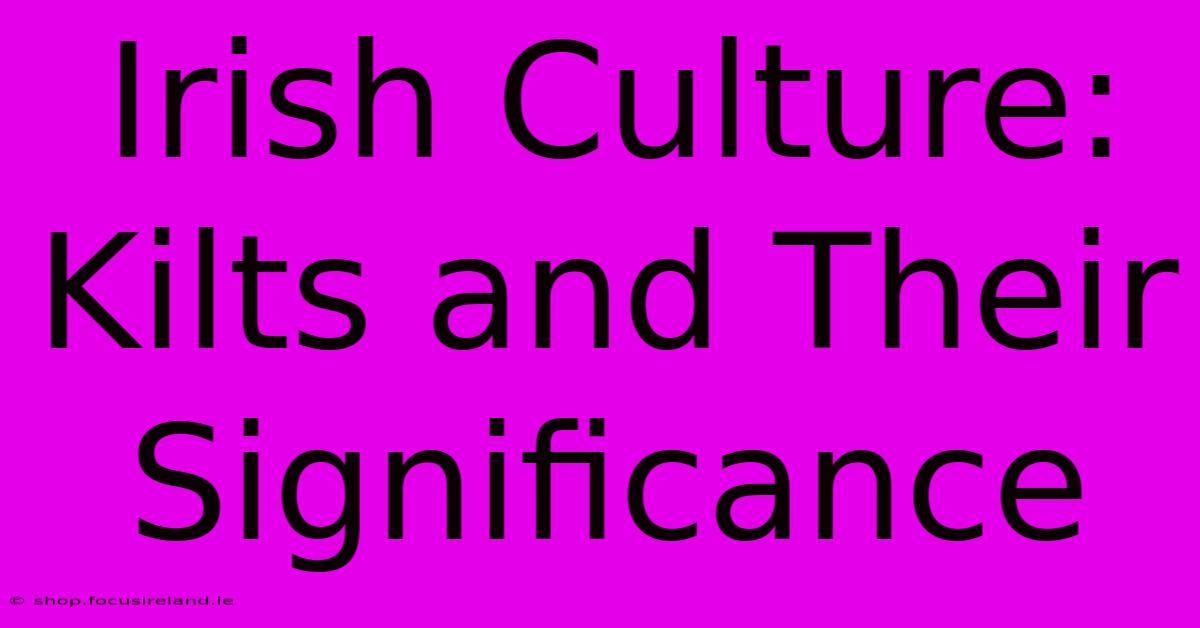Irish Culture: Kilts And Their Significance

Table of Contents
Irish Culture: Kilts and Their Significance
While kilts are strongly associated with Scottish culture, their presence in Irish culture, albeit less prominent, holds a unique and often misunderstood significance. This article delves into the history and symbolism of kilts within the Irish context, exploring their connection to Irish identity and traditions.
The Kilt's Journey: From Scotland to Ireland
The kilt, as we know it today, evolved from the belted plaid worn by Scottish Highlanders. Its history is deeply rooted in Scottish clan systems and Highland traditions. However, the garment's influence extended beyond Scotland's borders, finding its way into various cultural expressions across the British Isles, including Ireland.
It's crucial to understand that the kilts worn in Ireland are not a direct reflection of a long-standing, indigenous Irish tradition. Unlike Scotland's strong and deeply rooted kilt heritage, kilts in Ireland are a more recent adoption, often associated with specific groups, historical periods, or stylistic choices. They don't hold the same weight of historical and cultural lineage as their Scottish counterparts.
Irish Influences on Kilt Styles
While not traditionally Irish, kilts worn in Ireland may incorporate subtle influences from Irish design and aesthetics. This might include:
- Color palettes: The use of specific colors associated with Irish landscapes, mythology, or historical figures.
- Fabric choices: Selecting Irish-made tweeds or other fabrics.
- Embroidery or embellishments: Incorporating Celtic knots, traditional Irish patterns, or other motifs associated with Irish artistry.
These adaptations serve to personalize and localize the kilt, making it a more relevant expression of Irish identity for certain individuals or groups.
Kilts in Modern Irish Culture
Today, kilts in Ireland are not a ubiquitous sight. You're far less likely to see them as everyday wear compared to Scotland. However, they are occasionally seen at:
- Cultural events and festivals: Kilts may be donned at events celebrating Irish heritage or those with a broader Celtic theme.
- Special occasions: Weddings, formal gatherings, or historical reenactments might see individuals opting for kilts.
- Military or ceremonial attire: Certain Irish military units or ceremonial groups may incorporate kilts into their uniforms, demonstrating a visual link to broader Celtic traditions.
The Importance of Understanding Cultural Nuances
It's vital to approach the topic of kilts and Irish culture with sensitivity and an understanding of the historical context. While kilts can be a visually striking and expressive garment, it’s essential to avoid inappropriately conflating them with a core element of long-standing Irish tradition. They are an adopted garment, not an indigenous one. Misrepresenting their role can lead to misunderstandings and the trivialization of both Irish and Scottish cultural heritage.
Conclusion: A nuanced perspective
The presence of kilts in Ireland offers a fascinating study in cultural exchange and adaptation. Understanding their limited historical connection to Ireland is paramount to appreciating their role in modern Irish identity. While not a defining element of Irish tradition, their appearance in specific contexts reflects a broader appreciation of Celtic heritage and stylistic choices. Further research into the specific historical and cultural context in which kilts appear in Ireland provides a deeper, more nuanced perspective.

Thank you for visiting our website wich cover about Irish Culture: Kilts And Their Significance. We hope the information provided has been useful to you. Feel free to contact us if you have any questions or need further assistance. See you next time and dont miss to bookmark.
Featured Posts
-
Northern Ireland Co Ownership A Fresh Perspective On Homeownership
Mar 30, 2025
-
Explore Ireland Rent A Castle And Explore
Mar 30, 2025
-
5 Star Cork Relax Rejuvenate Revive
Mar 30, 2025
-
Affordable Coastal Living Irelands Hidden Treasure
Mar 30, 2025
-
Experience The Charm Cork City Property
Mar 30, 2025
